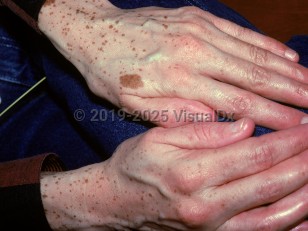Multiple lentigines syndrome in Adult
Alerts and Notices
Important News & Links
Synopsis

The multiple lentigines syndrome, also known as Noonan syndrome with multiple lentigines, LEOPARD syndrome, Gorlin syndrome II, cardio-cutaneous syndrome, lentiginosis profuse syndrome, and progressive cardiomyopathic lentiginosis, is one of the familial lentiginosis syndromes, a group of genetic disorders that are characterized by the presence of multiple lentigines as well as an increased incidence of cardiovascular, endocrine, and gastrointestinal neoplasias.
LEOPARD is an acronym for multiple lentigines, electrocardiographic conduction abnormalities, ocular hypertelorism, pulmonary stenosis, abnormal genitalia, retardation of growth, and sensorineural deafness. Some patients with this condition may also exhibit mild intellectual disability or speech difficulties. This syndrome occurs as a result of a mutation in the Noonan syndrome gene (a condition to which it is allelic), PTPN11. As a result, patients with LEOPARD syndrome commonly share clinical features with people who have Noonan syndrome. Although most cases result from sporadic mutations, the syndrome follows an autosomal dominant pattern of inheritance.
Lentigines present as small, asymptomatic, well-circumscribed, symmetric, homogenous, hyperpigmented macules. In LEOPARD, lentigines are usually small, < 5 mm in size, and tend to predominate on the trunk, but other areas may be involved, such as the palms, soles, buccal mucosa, genitalia, and scalp. Individual larger pigmented macules ranging in size from 1 to 1.5 mm may also be present. Patients tend to have a "speckled" appearance. Lentigines generally occur early in life (may be present at birth) and are not associated with sun exposure. Lentigines found on mucous membranes can be deeply pigmented, with increased size and irregular borders.
LEOPARD is an acronym for multiple lentigines, electrocardiographic conduction abnormalities, ocular hypertelorism, pulmonary stenosis, abnormal genitalia, retardation of growth, and sensorineural deafness. Some patients with this condition may also exhibit mild intellectual disability or speech difficulties. This syndrome occurs as a result of a mutation in the Noonan syndrome gene (a condition to which it is allelic), PTPN11. As a result, patients with LEOPARD syndrome commonly share clinical features with people who have Noonan syndrome. Although most cases result from sporadic mutations, the syndrome follows an autosomal dominant pattern of inheritance.
Lentigines present as small, asymptomatic, well-circumscribed, symmetric, homogenous, hyperpigmented macules. In LEOPARD, lentigines are usually small, < 5 mm in size, and tend to predominate on the trunk, but other areas may be involved, such as the palms, soles, buccal mucosa, genitalia, and scalp. Individual larger pigmented macules ranging in size from 1 to 1.5 mm may also be present. Patients tend to have a "speckled" appearance. Lentigines generally occur early in life (may be present at birth) and are not associated with sun exposure. Lentigines found on mucous membranes can be deeply pigmented, with increased size and irregular borders.
Codes
ICD10CM:
Q78.8 – Other specified osteochondrodysplasias
SNOMEDCT:
111306001 – Multiple lentigines syndrome
Q78.8 – Other specified osteochondrodysplasias
SNOMEDCT:
111306001 – Multiple lentigines syndrome
Look For
Subscription Required
Diagnostic Pearls
Subscription Required
Differential Diagnosis & Pitfalls

To perform a comparison, select diagnoses from the classic differential
Subscription Required
Best Tests
Subscription Required
Management Pearls
Subscription Required
Therapy
Subscription Required
References
Subscription Required
Last Updated:01/19/2022
Multiple lentigines syndrome in Adult

